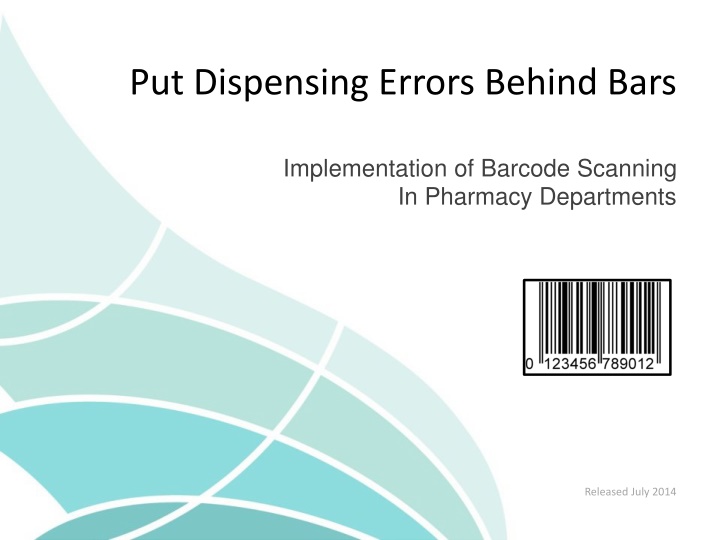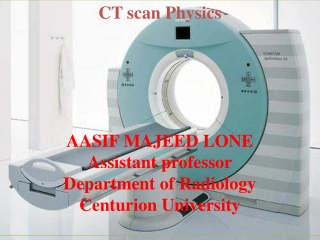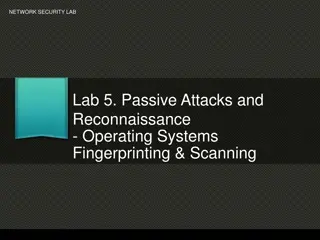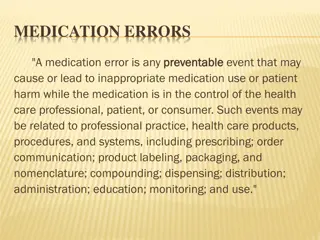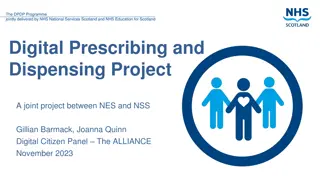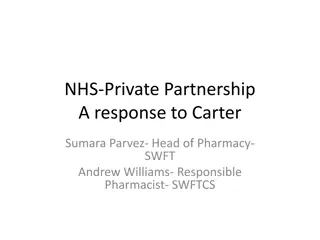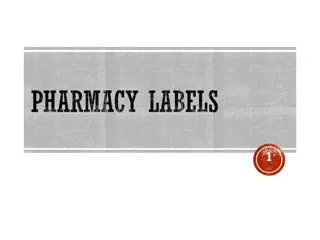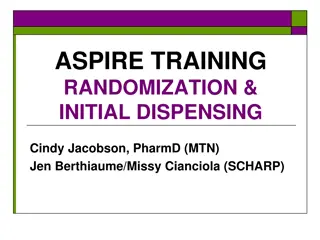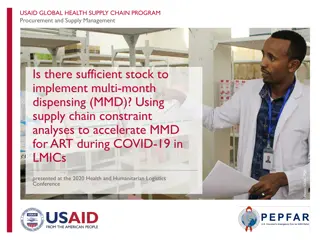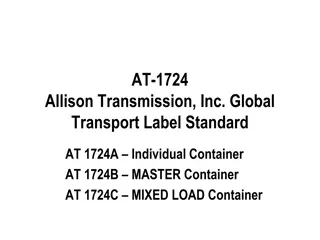Implementing Barcode Scanning to Reduce Dispensing Errors in Pharmacy
Implementation of barcode scanning in pharmacy departments has been shown to significantly reduce dispensing errors, ensuring greater accuracy in medication dispensation. Despite the generally low error rate among pharmacists, high volumes of dispensing can still lead to a substantial number of errors. Specific examples highlight the potential dangers of such errors and emphasize the importance of utilizing technology like barcode scanning to further decrease error rates.
Download Presentation

Please find below an Image/Link to download the presentation.
The content on the website is provided AS IS for your information and personal use only. It may not be sold, licensed, or shared on other websites without obtaining consent from the author.If you encounter any issues during the download, it is possible that the publisher has removed the file from their server.
You are allowed to download the files provided on this website for personal or commercial use, subject to the condition that they are used lawfully. All files are the property of their respective owners.
The content on the website is provided AS IS for your information and personal use only. It may not be sold, licensed, or shared on other websites without obtaining consent from the author.
E N D
Presentation Transcript
Put Dispensing Errors Behind Bars Implementation of Barcode Scanning In Pharmacy Departments Released July 2014
The Good Pharmacist Pharmacists are by nature (usually) very careful Jeff Kiger, Pharmacist: The perfect job for a perfectionist , PostBulletin.com, 8 Jan 2013 LOW rate of dispensing errors - 0.1% error rate 2
The Hidden Danger Even with a low error rate Highvolumes of dispensing can lead to a largenumber of errors For every 1,000 items dispensed, 1 dispensing error can occur 3
The 1 in 1,000 Error. Patient prescribed quetiapine 100mg daily Pharmacist dispensed 100mg tablets, but gave quetiapine 25mg tablets Community pharmacy picked up error during Webster packing No doses taken by patient; no harm caused 4
The 1 in 1,000 Error. Patient for doxycycline 100mg daily on hospital discharge Patient given Oxycontin 100mg Nil history of opioid use Patient took the Oxycontin 100mg as directed Readmitted with opioid- induced narcosis 5
The 1 in 1,000 Error. Post-op patient for ciprofloxacin 500mg bd for surgical prophylaxis Pharmacist incorrectly gave citalopram 20mg tablets Patient took citalopram 20mg, one tablet bd as directed Continued for two days Readmitted to hospital with sepsis requiring ICU admission 6
The 1 in 1,000 Error. Renal patient on Pegatron 120mcg + 140 combipack Pegatron dispensed but Pegasys 180mcg + 140 combipack given by mistake Patient took medication home, realised pack looked different and called Liver Clinic Returned Pegasys without taking any doses and picked up Pegatron Pegasys needed to be discarded Cost to facility = around $3,200 7
Reducing the Error Rate Further Barcode scanning has been shown to reduce product selection errors Studies have shown a 85% reduction in targeted dispensing errors (0.37% to 0.06%) 8
http://media.cirrusmedia.com.au/PN_Media_Library/News/barcode_1.jpghttp://media.cirrusmedia.com.au/PN_Media_Library/News/barcode_1.jpg What is Barcode Scanning Patient safety initiative Way of checking the identity of product dispensed to product selected However, barcode scanning doesn t fix all errors . 9
Errors Barcode scanning detects errors associated with: 1. Incorrect product selection (compared to data entry) 2. Incorrect assembly (e.g. applying the incorrect label to the product) Does not prevent data entry errors 10
Error Type Avoided by Barcode Scanning NOT Avoided by Barcode Scanning Wrong patient Wrong medicine entered into iPharmacy Wrong medicine chosen from shelf Wrong strength entered into iPharmacy Wrong strength chosen from shelf Wrong quantity entered into iPharmacy Wrong quantity chosen from shelf Wrong formulation entered into iPharmacy Wrong formulation chosen from shelf Omission (failure to dispense) Wrong directions Wrong dispensing label 11
Recommendations The use of barcode scanners is strongly recommended by Pharmacy Board of Australia, Guidelines for dispensing of medicines SHPA, Standards of Practice for Hospital Pharmacy Outpatient Services PSA, Professional Practice Standard 5: Dispensing National Safety and Quality Health Service Standards 12
Benefits 1. Reduces the rate of preventable medication (selection) errors 2. Decreases incidence of patient harm 3. Saves money by reducing drug waste 4. Complies with pharmacy professional practice standards 5. Demonstrates compliance with accreditation standards 13
Barcode Scanning and the Dispensary Workflow 14
How to Use Barcode Scanning Barcode scanning often used incorrectly Should NOT be used to assist data entry Should be used during final stages of dispensing .just prior to attaching the label Once a barcode scanning check is completed, strike out the barcode 15
The Dispensing Workflow Scan TWO barcodes: 1. On dispensing label 2. On manufacturers packaging Data Entry Product Selection Patient Identifiers AND Medication Information The system will alert you if they do NOT match Label Produced Product Selection Final Check Label 16
Who Should Scan? The person completing the final stages of dispensing i.e. the person attaching the label This could include: The pharmacist dispensing The technician/grad dispensing (prior to pharmacist final check) The pharmacist checking and packing (after a technician/grad has entered data, produced a label and selected the product) 17
What Medications Need Scanning? Ideally, ALL medications should be scanned Some departments will start with Outpatient (full box) dispensing only EXCLUSIONS: i. Medications that are part of a trial or study ii. SAS medications iii. Extemporaneous products 18
Trouble-Shooting The barcode on the original box/bottle isn t recognised in iPharmacy. What to do? 1. Write down the medication name, strength, formulation 2. Give details to <delegate/s name/s> 3. <delegates name> will contact HealthShare NSW 4. Dispense as normal. Barcode scanning will not be available so do a double/triple check! 19
Thank you Questions For further information: medicationsafety@cec.health.nsw.gov.au www.cec.health.nsw.gov.au +
